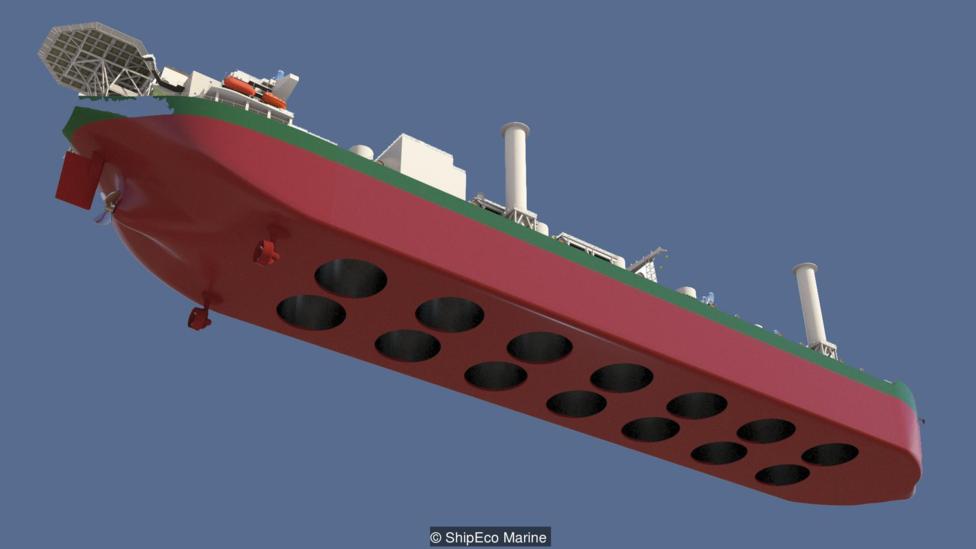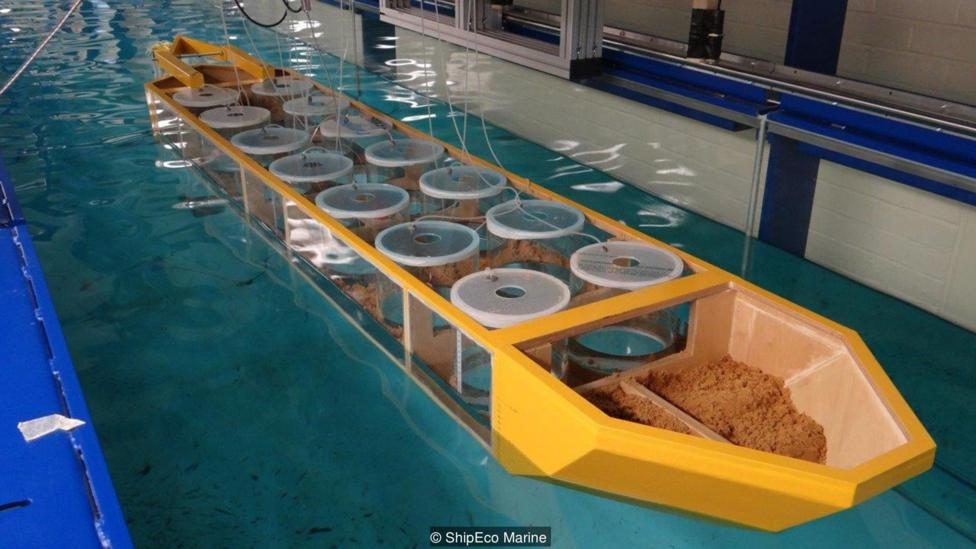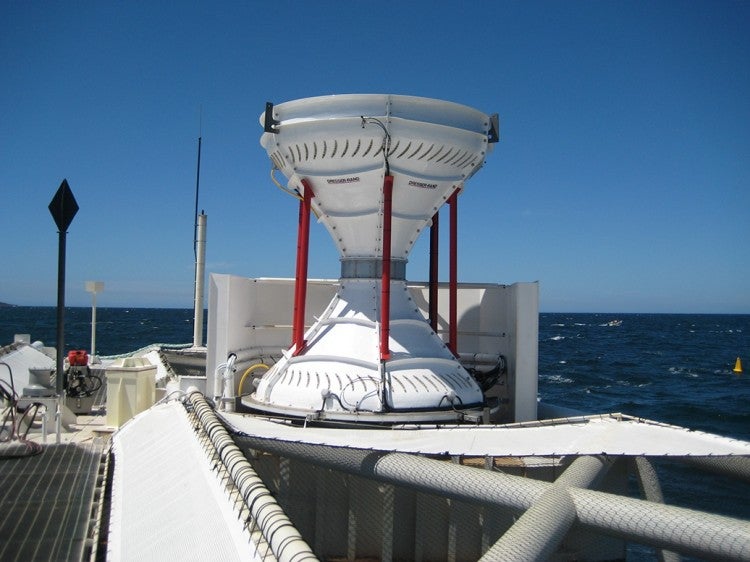There are thousands of giant oil tankers crisscrossing the world’s oceans with their cargoes of death-dealing products. Every year, a hundred or so are retired. Many of those are run aground off the coast of Bangladesh where they are cut up for scrap by unskilled workers who risk life and limb to eke out a meager existence.

Image courtesy ShipEco Marine
ShipEco Marine has a better idea — cut large holes in the hull of these behemoths, build watertight silos inside, and let the waves passing beneath them compress the air inside those silos. The air pressure can then be harvested to run electrical generators. Think of it as wind turbines that operate horizontally.
“The current problem with most wave energy projects is that they are fixed in place, close to the shore so they can be connected to the electricity grid,” Andrew Deaner, managing director of ShipEco Marine, tells the BBC. “This isn’t necessarily where the best waves are. With a ship you are mobile, so you can move to the edge of low pressure weather systems where the waves are bigger and there is more energy.”
“It works like a giant piston,” says Florent Trarieux, a renewable energy engineer who has tested the “waveship” concept in scale models at Cranfield University. “We would put a turbine at the top of the chamber that is driven by the air as it is pulled back and forth by the water. We could put these in columns all down the length of a ship like an oil tanker.” Those laboratory tests have shown the “waveship” concept is at least feasible.
“There are thousands of oil tankers currently in operation and hundreds reaching the end of their service lives every year,” says Trarieux. “All that steel could be cut up and reused, or we could repurpose them to make wave energy. Effectively we would be going ‘fishing for energy.’” Out on the open ocean where unimpeded winds can generate larger waves, the amount of energy that can be generated is many times greater than can be produced in coastal areas. “It is a completely different approach to wave energy.”

Image courtesy ShipEco Marine
Early experiments designed to harvest energy from wave action were largely unsuccessful. But recent work by Siemens on oscillating water column technology has had better results. According to the Siemens website, “The challenge of OWC turbine technology is to achieve satisfactory efficiency over a wide operating range. The airflow not only varies between zero and 100 percent, but also changes direction as it reciprocates. At the same time, the shaft rotation must be maintained in one direction (i.e. clockwise rotation).
“Siemens patented the HydroAir™ turbine which is able to resolve the challenges present in wave energy conversion while offering outstanding performance and reliability. Constructed to withstand the rigors of a marine environment and ambient conditions, it uses a combination of corrosion-resistant stainless steel, aluminum and reinforced composites which also yield to reduced weight.”

Image courtesy Siemens
Okay. So you have these big ships with holes cut into the bottom roaming the oceans in search of waves. What do you do with the electricity they generate if you are too far from shore for a transmission line? Deaner has an answer to that question.
“We are looking at producing fresh water — we think we could make somewhere between 18,000 and 36,000 tonnes a day before bringing it ashore. We could also make hydrogen or liquid nitrogen which we could sell to industry. “We are looking at making products onboard so we are not tied to any electricity grid connection. If someone wanted to put a chocolate factory on the deck of our waveship we could actually be manufacturing products as it is being shipped to markets around the world.”
Not everyone is convinced the ShipEco Marine idea is sound. Stephen Salter, a leading wave energy expert at the University of Edinburgh, says air turbines may struggle to cope with the wide range of flow speeds caused by natural waves on the ocean. He also worries about how resilient an oil tanker would be on the high seas with holes cut in its hull “Cutting a round hole raises stress by a factor of three. If the tanker designer did a good job, then a great deal of modification will be needed. Any sharp corners will also dissipate lots of energy.”
What Else Can You Do With A Super Tanker?
If Stephen Salter is right, what other uses might there be for decommissioned super tankers? Any number of things. Chris Collaris of the Netherlands thinks they could be converted into shorefront public buildings containing shopping malls, concert venues, museums, swimming pools and a public park on the top deck. Collaris says he has yet to find anyone brave enough to take the concept beyond the concept stage.
EnviroNor of Norway thinks the big tankers could be converted into mobile wastewater treatment plants that would be sent to cities around the world that are struggling with water shortages. It says a single tanker could treat the wastewater from a city of 250,000 people. Mooring them near offshore wind farms would allow them to use renewable energy to desalinate water for coastal cities.
Since 1985, 39 tankers of various sorts have been sunk off the coast of the US and one off the coast of Malta where they serve as marine habits for aquatic plants and animals. Some have formed the foundation of artificial coral reefs to replace those that are dying from rising ocean temperatures and acidity.
“If they are cleaned properly, oil tankers have a very big surface for things to attach to underwater and they will have a long lifespan,” says Dalia Conde, director of science at Species 360, an international conservation research organization. “There is the potential to attract a lot of fish, mollusks, different seaweeds.”
While the idea of a ship that helped destroy the global environment being reused to create new habitats is appealing, perhaps the best idea yet for what to do with an old supertanker has been put forth by New York City artist Dustin Yellen. He would like to take a 1,000 foot long tanker and anchor it vertically in New York harbor with the stern pointed at the sky to remind people of the need for humanity to end the fossil fuel era as quickly as possible.